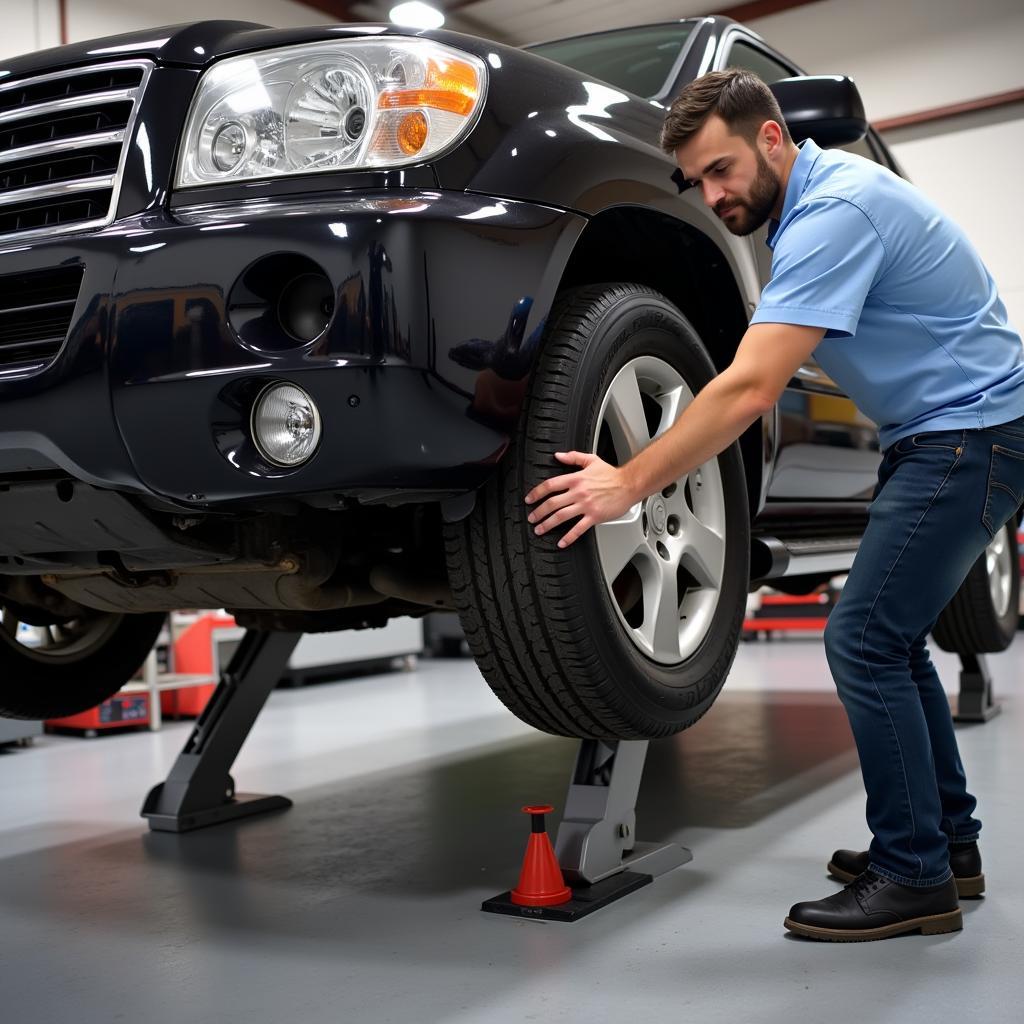Jacking up a car might seem daunting, especially if you’re a novice DIYer. But with the right knowledge and tools, it’s a task anyone can master. Whether you’re changing a tire, inspecting your brakes, or performing other under-car maintenance, knowing how to safely jack up your car is essential. This guide will provide a comprehensive, Chris Fix-inspired approach to ensure you can confidently lift your car like a pro.
Understanding the Fundamentals of Jacking Up a Car
Before you rush into lifting your car, let’s lay a solid foundation by understanding the key elements involved:
-
The Importance of a Level Surface: Never, ever attempt to jack up your car on a slope or uneven ground. Always find a flat, stable surface like a concrete driveway or garage floor. This ensures the car remains stable while lifted.
-
Identifying the Correct Jacking Points: Your car’s owner’s manual is your best friend here. It will clearly indicate the designated jacking points, usually reinforced areas of the chassis designed to bear the car’s weight.
-
Choosing the Right Jack: Using the wrong type of jack can damage your car or even lead to dangerous accidents. There are various types, but for most car owners, a floor jack or a scissor jack (usually included with your car) will suffice. Make sure the jack’s weight capacity exceeds your car’s weight.
 Choosing the Right Jack and Jack Stands
Choosing the Right Jack and Jack Stands
A Step-by-Step Guide to Safely Jacking Up Your Car
Now, let’s break down the jacking process into clear, easy-to-follow steps:
-
Prepare Your Car: Engage your parking brake firmly and put your car in “Park” (or first gear for manual transmissions). If you’re changing a tire, loosen the lug nuts slightly before lifting the car.
-
Position the Jack: Place the jack directly beneath the designated jacking point. If you’re using a floor jack, ensure it’s properly aligned before pumping.
-
Begin Jacking: Pump the jack handle smoothly and steadily until it makes contact with the car. Double-check the jack is positioned correctly and hasn’t shifted. Continue jacking until the tire is slightly off the ground.
-
Secure with Jack Stands: Never solely rely on a jack to support your car. Once the car is lifted, place jack stands under designated jacking points for added safety. Lower the car slowly onto the jack stands, ensuring they’re stable and bearing the weight.
 Securing the Car on Jack Stands
Securing the Car on Jack Stands
- Double-Check Stability: Before proceeding with any work, give the car a gentle shake to ensure it’s stable on the jack stands.
Lowering Your Car Safely
After you’ve finished your work, it’s crucial to lower the car correctly to avoid any injuries or damage:
-
Clear the Area: Make sure there are no tools, debris, or body parts underneath the car.
-
Raise Slightly: Using the jack, lift the car just enough to take the weight off the jack stands.
-
Remove the Jack Stands: Carefully slide the jack stands out from under the car.
-
Lower the Car: Slowly lower the car by gently releasing the jack’s pressure. Don’t rush this process.
-
Tighten Lug Nuts (If Applicable): If you were changing a tire, tighten the lug nuts in a star pattern to ensure even pressure.
Expert Insights:
As seasoned mechanic, Chris Fix Eric the Car Guy, often emphasizes, “Safety should always be your number one priority when working on your car, especially when it’s lifted.” He further advises, “Investing in a good quality jack and jack stands is not something you should compromise on.”
 Verifying Car Stability
Verifying Car Stability
Conclusion
Mastering the art of safely jacking up a car empowers you to tackle various car maintenance tasks independently. By following this comprehensive guide, you’ll be equipped with the knowledge and confidence to lift your car like a pro. Remember, always prioritize safety and refer to your owner’s manual for specific instructions related to your car model.
Need help? Don’t hesitate to contact the automotive experts at AutoTipPro for personalized guidance. Call us at +1 (641) 206-8880 or visit our office located at 500 N St Mary’s St, San Antonio, TX 78205, United States.




Leave a Reply